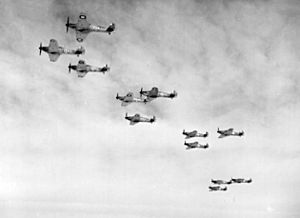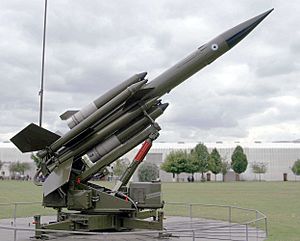No. 85 Squadron RAF facts for kids
Quick facts for kids No. 85 Squadron RAF |
|
|---|---|
| Active | 1 August 1917 – 3 July 1919 1 June 1938 – 31 October 1958 30 November 1958 – 31 March 1963 1 April 1963 – 19 December 1975 19 December 1975 – 1 July 1991 2008 – August 2011 |
| Country | |
| Branch | |
| Nickname(s) | Flying Foxes |
| Motto(s) | Latin: Nocto Diuque Venamur ("We hunt by day and night") |
| Post-1950 aircraft insignia |  |
| Battle honours | Western Front, 1917–1918; France & Low Countries, 1939–1940; Battle of Britain, 1940; Home Defence, 1940–1944; Fortress Europe, 1943; Normandy, 1944; France & Germany, 1944–1945. |
| Commanders | |
| Notable commanders |
William Avery "Billy" Bishop Edward "Mick" Mannock Peter Townsend John Cunningham |
| Insignia | |
| Squadron Badge | On an ogress a hexagon voided The hexagon was no. 85's World War I identity insignia and the ogress signifies the night |
| Squadron Codes | NO (Sep 1938 – Sep 1939) VY (Sep 1939 – Apr 1951) |
No. 85 Squadron was a famous flying unit of the Royal Air Force (RAF). It was known for its brave pilots and important missions in both World War I and World War II. The squadron was nicknamed the "Flying Foxes" and its motto was "We hunt by day and night." It was active for many years, helping to defend the United Kingdom and fight in major conflicts. The squadron last served in 2011, teaching new pilots how to fly.
Contents
History of No. 85 Squadron
World War I Missions
No. 85 Squadron was first formed on August 1, 1917. It started at Upavon, which was a training base for the Royal Flying Corps. Soon after, the squadron moved to Mousehold Heath and then to Hounslow Heath Aerodrome. In March 1918, a famous pilot named Major William Avery Bishop took command. He was a hero who had won the Victoria Cross, a very high award for bravery. His job was to get the squadron ready for fighting in France.
On April 1, 1918, No. 85 Squadron became part of the new Royal Air Force. In May 1918, they went to France. They flew Sopwith Dolphin and later Royal Aircraft Factory S.E.5A planes. These were fighter planes used to patrol the skies and attack targets on the ground over the Western Front. They continued these missions until the war ended.
Another important leader, Major Edward Mannock, joined the squadron on June 21, 1918. He taught the pilots to fight as a team, not just as individuals. Sadly, Major Mannock did not return from a patrol on July 26, 1918. He was later given the Victoria Cross for his bravery. No. 85 Squadron achieved 99 victories during its time in World War I. Besides Bishop and Mannock, other skilled pilots, known as "aces" (pilots who shot down many enemy planes), flew with the squadron. These included Malcolm C. McGregor and Lawrence Callahan. The squadron returned to the UK in February 1919 and was officially closed down on July 3, 1919.
World War II Operations
No. 85 Squadron was started again on June 1, 1938. It was based at RAF Debden in Essex. The squadron began training with Gloster Gladiator planes, which were the last biplane (two-winged) fighters used by the RAF. By September, they started getting the faster Hawker Hurricane planes. As war seemed likely in Europe, the squadron was told to get ready for action on August 23, 1939. Their planes were kept ready to fly at any moment.
When Second World War began, the squadron moved its 16 Hurricanes to France. They were part of the British Expeditionary Force and their main job was to support other British planes and protect their airfields. They flew patrols over the English Channel. In December 1939, the King visited the squadron. The winter was very tough, with freezing weather making it hard to fly and causing problems for the planes and pilots.
When Germany launched its fast attack, known as the Blitzkrieg, in May 1940, No. 85 Squadron faced intense battles against the German air force, the Luftwaffe. Their airfields were often attacked, so they had no break from fighting. In just eleven days, the squadron shot down 90 enemy aircraft. They also helped protect the Allied armies until their airfields were taken over. The three remaining planes returned to the UK. During these fierce battles in France, the squadron lost seventeen pilots.
The squadron quickly got new planes and was ready for action again in June 1940. They took part in the first part of the Battle of Britain over southern England. In September, they moved to Yorkshire and changed their role to become "night fighters." This meant they flew missions at night to stop enemy bombers. For the rest of World War II, No. 85 Squadron continued to hunt enemy planes in the dark. They also helped protect bombers and even stopped V1 flying bombs, which were early German missiles.
Into the Jet Age
After World War II ended in Europe, 85 Squadron continued to be a night-fighter unit. They started flying new types of jet aircraft, like the Gloster Meteor, Gloster Javelin, and English Electric Canberra.
On December 19, 1975, No. 85 Squadron was formed again, but this time as a unit that used Bristol Bloodhound Mark II surface-to-air missiles. These missiles were used to shoot down enemy aircraft from the ground. The squadron was based at several RAF stations in the UK, with its main base at RAF West Raynham. They played a big part in defending the UK's airspace as part of the RAF's air defense system until the 1990s.
When the Cold War ended and the Warsaw Pact (a group of countries allied against Western nations) broke up, the UK's air defense needs changed. Because of these changes, No. 85 Squadron was officially closed down on July 31, 1991. The squadron's special flag, which showed its battle honors, was placed in Ely Cathedral for safekeeping.
In 2008, No. 85 Squadron was started again as No. 85 (Reserve) Squadron. It was based at RAF Church Fenton and taught new pilots how to fly using Grob Tutor planes. However, in August 2011, the squadron was closed down again. This happened because the RAF had to make cuts after a review of the UK's defense needs.
In 2017, No. 85 Squadron celebrated its 100th Anniversary, remembering its long and important history of serving the United Kingdom.
See also
- List of Royal Air Force aircraft squadrons



